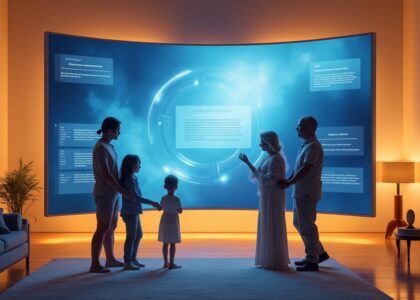Whether it’s historical buildings, car shows, or concert stages, these projectors elevate the visual experience to a whole new level.
Projection mapping projectors are revolutionizing the world of visual effects and projections. Unlike standard projectors, they can project images onto complex surfaces and objects, creating the illusion of vibrant, moving decorations or dramatic light effects.
Projection Mapping Projectors. Why to choose them?
Projection mapping projectors are cutting-edge devices that go beyond the limitations of traditional projectors, opening up a new world of creative possibilities. Unlike standard projectors, which project flat images onto screens or walls, projection mapping projectors are designed to adapt visuals to irregular surfaces – such as buildings, sculptures, or even cars – transforming them into dynamic, immersive displays.
How a Projection Mapping Projector Differs from a Standard Projector
Projection mapping projectors stand out from standard models due to specialized features that allow for stunning visuals on complex surfaces:
- High Brightness: Powerful lamps or lasers ensure clear, vibrant images even on large or outdoor surfaces, standing out against ambient light.
- Precise Resolution & Color Accuracy: Delivers lifelike detail and accurate colors, essential for projecting onto irregular shapes.
- Software Integration: Specialized mapping software warps and aligns visuals to fit complex surfaces perfectly, allowing adjustments like stretching, rotating, and blending multiple projectors seamlessly.
What is Projection Mapping?

Projection mapping is an innovative visual technique that allows for projecting images, animations, or videos onto non-flat surfaces like buildings, objects, and irregular shapes. Unlike standard projection, which relies on flat screens, projection mapping uses specialized projectors and software to adapt visuals to the unique contours and dimensions of various surfaces.
Key Components of a Projection Mapping Projector
Projection mapping projectors are powered by essential components that make them uniquely capable of mapping visuals onto complex surfaces:
- High-Lumen Lamp/Laser: Provides the intense brightness needed for clear projections on large or irregular surfaces, even outdoors.
- Advanced Lens Options: Allows for precise focus and flexibility, essential for adapting to different projection distances and angles.
- Warping and Edge-Blending Capabilities: Ensures seamless visuals across multiple projectors, creating one unified image.
- Image Processing Software: Enables accurate alignment and mapping of visuals to match the surface’s shape, enhancing the overall effect.
Applications of Projection Mapping Projectors
- Entertainment and Events: Concerts, festivals, and live shows leverage projection mapping to transform stages and venues, synchronizing visuals with performances to captivate audiences with immersive, moving imagery.
- Marketing and Advertising: For product launches and promotional campaigns, brands project 3D visuals onto buildings or products, creating eye-catching displays that make a lasting impression.
- Art Installations and Museums: Artists and museums utilize projection mapping to add movement and depth to static exhibits, creating interactive, memorable experiences for visitors.
- Architecture and Education: Projection mapping offers architects a tool to showcase design concepts on buildings or structures, while educators use it to visualize complex topics, enhancing learning with engaging visuals.
Advantages of Using Projection Mapping Projectors
Projection mapping projectors offer several compelling advantages, making them a powerful tool for creating captivating visual experiences:
- Immersive Visuals: These projectors transform ordinary surfaces into engaging, 3D-like canvases. By projecting onto irregular shapes or large structures, they create a unique, immersive environment that pulls audiences into the visual story.
- Versatility Across Settings: Projection mapping projectors are adaptable for various applications, from concerts and corporate events to art installations and educational settings. Their flexibility allows them to project on any surface – be it buildings, sculptures, or landscapes.
- Audience Engagement: With the ability to create dynamic, interactive visuals, projection mapping grabs attention and leaves a memorable impact. This is particularly useful in marketing, entertainment, and public events, where engagement is key.
- High Brightness for Any Environment: Equipped with high-lumen outputs, these projectors deliver vivid images in both bright indoor and outdoor settings, ensuring clarity and impact under different lighting conditions.
- Adaptability to Different Surfaces: With features like edge-blending and warping capabilities, projection mapping projectors can align visuals seamlessly on complex surfaces, making them suitable for even the most challenging projections.
Conclusion: Why Projection Mapping Projectors Are Changing Visual Experiences
Projection mapping projectors represent a groundbreaking advancement in visual technology, transforming ordinary surfaces into dynamic, immersive displays.
- Unlike standard projectors, these specialized devices adapt images to complex shapes, making them ideal for large-scale events, art installations, and innovative advertising.
- With features like high brightness, precise color accuracy, and advanced software for warping and blending visuals, projection mapping projectors turn buildings, sculptures, and objects into interactive canvases that captivate and engage.
Projection mapping finds versatile use across many industries, bringing dynamic visuals to life:
- Entertainment and Events,
- Marketing and Advertising,
- Art and Museums,
- Architecture and Urban Design,
- Education and Training,
- Hospitality and Tourism.
As technology advances, its potential uses continue to grow, pushing the boundaries of visual engagement and immersion.
What do you think of projection mapping shows?





